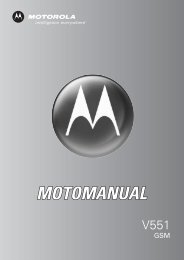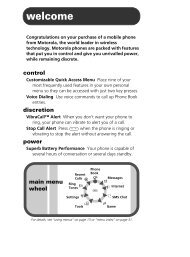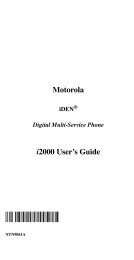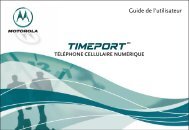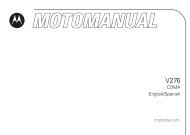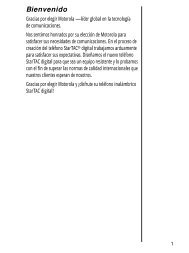Identifying electrical and mechanical design milestones is very ...
Identifying electrical and mechanical design milestones is very ...
Identifying electrical and mechanical design milestones is very ...
You also want an ePaper? Increase the reach of your titles
YUMPU automatically turns print PDFs into web optimized ePapers that Google loves.
Value of Implementing a Robust Test Plan During Product Design of Portable Systems<br />
By<br />
LaW<strong>and</strong>a Quarles<br />
Senior Reliability Engineer<br />
Motorola Product Testing Services<br />
<strong>and</strong><br />
Chr<strong>is</strong> Shelton<br />
Senior Reliability Engineer<br />
Motorola Product Testing Services<br />
The timely introduction of a robust test plan during product <strong>design</strong> of a portable system <strong>is</strong> crucial<br />
to avoid <strong>is</strong>sues that may negatively impact a product’s cost <strong>and</strong> time-to-market. Last minute<br />
<strong>design</strong> changes stemming from test failures may create an increase in product cost that can<br />
negatively affect the operating profit. In addition, a product that <strong>is</strong> late to market due to test<br />
failures that require <strong>design</strong> changes can almost guarantee customer d<strong>is</strong>sat<strong>is</strong>faction.<br />
There are a few key <strong>electrical</strong> <strong>and</strong> <strong>mechanical</strong> <strong>design</strong> <strong>milestones</strong> early in the <strong>design</strong> cycle when<br />
testing can be performed to almost eliminate last minute <strong>design</strong> changes. To identify <strong>and</strong><br />
underst<strong>and</strong> what these are, it <strong>is</strong> important to first underst<strong>and</strong> the major <strong>milestones</strong> in the<br />
development cycle of a portable electronic device. From a testing point of view, the <strong>milestones</strong><br />
in the development cycle are:<br />
• Defining Product Specification<br />
• Establ<strong>is</strong>hing Printed Circuit Board (PCB) Design<br />
• Establ<strong>is</strong>hing Mechanical Design<br />
• Releasing Prototype Samples<br />
• Releasing Engineering Samples<br />
• Releasing Final Production<br />
Although each of these <strong>milestones</strong> <strong>is</strong> important to the <strong>design</strong> process, the two most critical from<br />
a testing perspective are establ<strong>is</strong>hing a PCB <strong>and</strong> <strong>mechanical</strong> <strong>design</strong>. Proper testing at these<br />
two phases of the process affords the opportunity to resolve most <strong>is</strong>sues <strong>and</strong> fine-tune the<br />
product <strong>design</strong> without delaying the product’s scheduled ship date.<br />
Defining Product Specifications<br />
Creating a product specification <strong>is</strong> an integral milestone in the <strong>design</strong> process. Th<strong>is</strong><br />
specification thoroughly defines the product, the systems in which it <strong>is</strong> utilized, <strong>and</strong> the agency<br />
approvals that the product requires. Obtaining the information in the product specification early<br />
in the <strong>design</strong> process allows you to create a roadmap for testing that can be performed when<br />
the PCB <strong>and</strong> <strong>mechanical</strong> <strong>design</strong>s have been establ<strong>is</strong>hed.<br />
Establ<strong>is</strong>hing PCB Design<br />
Establ<strong>is</strong>hing PCB <strong>design</strong> <strong>is</strong> the most crucial <strong>electrical</strong> milestone. Th<strong>is</strong> <strong>is</strong> the point in the <strong>design</strong><br />
process where the theoretical analys<strong>is</strong> of the circuit <strong>is</strong> completed <strong>and</strong> samples are available of<br />
the populated PCB. At th<strong>is</strong> key <strong>electrical</strong> milestone, a couple of key <strong>design</strong> verification type<br />
tests can be performed using the populated PCB along with a stereo-lithography apparatus<br />
(SLA) housing. Two tests that are particularly informative at th<strong>is</strong> stage are pre-compliance<br />
electromagnetic compatibility (EMC) scans <strong>and</strong> vibration testing
A power supply for a personal digital ass<strong>is</strong>tant (PDA) <strong>is</strong> a good example of where precompliance<br />
EMC scans, performed at the establ<strong>is</strong>hment of the PCB <strong>design</strong>, can prove to be<br />
<strong>very</strong> beneficial. The majority of the PDAs on the market have the capabilities to send <strong>and</strong><br />
receive information to a personal computer via a USB connection. Therefore, in order to<br />
properly test a power supply for use in th<strong>is</strong> type of system, you must test not only the power<br />
supply, but also the whole system including power supply, PDA, <strong>and</strong> computer- through the<br />
USB connection. The addition of the power supply <strong>and</strong> computer USB connection can create a<br />
much more complex overall system where EMC test results can vary enough to affect<br />
compliance to Federal Communications Comm<strong>is</strong>sion (FCC) regulations <strong>and</strong> the European EMC<br />
Directive.<br />
Since PCB layout can have a significant impact on EMC testing results, performing precompliance<br />
radiated em<strong>is</strong>sions <strong>and</strong> conducted em<strong>is</strong>sions “quick scans” can provide a good idea<br />
of where a product st<strong>and</strong>s in compar<strong>is</strong>on to the regulations. Obtaining these results at th<strong>is</strong> point<br />
in the <strong>design</strong> process will identify any problems with the layout of the PCB, <strong>and</strong> provide the time<br />
to make the necessary changes without impacting the product ship date. In compar<strong>is</strong>on,<br />
identifying the same <strong>is</strong>sues at the release of engineering samples <strong>is</strong> too late in the process <strong>and</strong><br />
will negatively affect the ship date of the project.<br />
Vibration <strong>is</strong> another test that <strong>is</strong> best performed when the PCB <strong>design</strong> <strong>is</strong> establ<strong>is</strong>hed. Almost all<br />
<strong>design</strong> verification (DV) test programs, as well as the UN Recommendation on the Transport of<br />
Dangerous Goods regulation, require vibration testing. The purpose of the <strong>design</strong> verification<br />
vibration test <strong>is</strong> to simulate the way a product will be stressed during transportation, as well as<br />
verifying its overall durability. The vibration test <strong>is</strong> <strong>very</strong> important in determining the proper<br />
placement of components, the suitability of components utilized, <strong>and</strong> the integrity of the<br />
components as they are placed on the PCB.<br />
The vibration test performed during the <strong>design</strong> verification process should be <strong>very</strong> stringent. In<br />
some instances, th<strong>is</strong> can cause components to be sheared off of the PCB. Th<strong>is</strong> can happen if<br />
they are placed too close to the housing, or if they are just not strong enough to withst<strong>and</strong> the<br />
forces of the test. Issues like these can require PCB layout changes or housing modifications.<br />
So if the testing <strong>is</strong> performed at the PCB <strong>design</strong> set milestone, there <strong>is</strong> enough time to make<br />
changes. Unfortunately, many wait until the release of the engineering sample milestone to<br />
submit for DV testing. Since th<strong>is</strong> <strong>is</strong> extremely late in the <strong>design</strong> process, if any failures are<br />
noted, the product will ship late <strong>and</strong> costs will increase.<br />
Establ<strong>is</strong>hing Mechanical Design<br />
Establ<strong>is</strong>hing <strong>mechanical</strong> <strong>design</strong> <strong>is</strong> the point in the <strong>design</strong> process where housing layout <strong>is</strong><br />
complete, dimensional data <strong>is</strong> available, <strong>and</strong> construction material has been chosen. When the<br />
<strong>mechanical</strong> <strong>design</strong> of a product <strong>is</strong> establ<strong>is</strong>hed <strong>and</strong> sample housings can be built, it <strong>is</strong> critical to<br />
begin preliminary testing. Many environmental <strong>and</strong>/or <strong>mechanical</strong> tests can be performed on<br />
the first pre-production builds of a product’s housing using non-functional or old rev<strong>is</strong>ion PCBs if<br />
the PCB layout <strong>is</strong> not yet establ<strong>is</strong>hed. Waiting until final tooling or completion of the <strong>electrical</strong><br />
<strong>design</strong> <strong>is</strong> not necessary.<br />
Some of the tests that can be performed at the earliest stages of development are thermal<br />
shock, temperature <strong>and</strong> humidity cycling, vibration, <strong>and</strong> r<strong>and</strong>om drop. The stresses involved in<br />
these tests are excellent indicators of how a product will perform <strong>mechanical</strong>ly over its lifetime<br />
<strong>and</strong> can quickly lead to possible product <strong>design</strong> changes. These tests can expose <strong>is</strong>sues with<br />
the materials such as brittle plastic, areas of insufficient wall thickness, <strong>and</strong> gluing or welding
concerns. Waiting to perform testing until late in the <strong>design</strong> process or even until final<br />
production build can result in extended product <strong>design</strong> cycle time <strong>and</strong> m<strong>is</strong>sed ship dates.<br />
Releasing Engineering Samples<br />
One example that supports the need for early testing <strong>is</strong> a manufacturer who waits until<br />
engineering samples are produced to begin accelerated life testing (ALT). If during a drop test it<br />
<strong>is</strong> d<strong>is</strong>covered that the product housing cracks in a particular area, the development team would<br />
be forced to re-evaluate the product <strong>design</strong> to find a solution to the cracking <strong>is</strong>sue. At th<strong>is</strong> point,<br />
the manufacturer’s customer would have samples in h<strong>and</strong> <strong>and</strong> the ship acceptance date for the<br />
product would be rapidly approaching. Additional resources <strong>and</strong> an accelerated test schedule<br />
would be required to implement <strong>and</strong> test the various solutions that were proposed. If testing<br />
had been performed earlier in the <strong>design</strong> phase, the <strong>is</strong>sue could have been identified <strong>and</strong><br />
corrected prior to the customer receiving samples. Earlier testing would have also prevented<br />
the cost of expedited testing that was required to validate the product change.<br />
Releasing Final Production<br />
Simply stated, one should never allow oneself to get to th<strong>is</strong> point. The major concern with<br />
releasing final production <strong>is</strong> that a potential field action may be needed to address <strong>is</strong>sues with<br />
product that has already shipped.<br />
Release of Prototype Samples<br />
If a manufacturer waits until prototype level samples are available, unacceptable delays are<br />
likely. Additionally, the delays <strong>and</strong> costs of shipping product Class-9 (M<strong>is</strong>cellaneous Hazardous<br />
Goods) until testing <strong>is</strong> completed will impede the deli<strong>very</strong> of samples to the customer <strong>and</strong><br />
potentially add delays to the development cycle. Having the testing performed at the<br />
establ<strong>is</strong>hment of <strong>mechanical</strong> <strong>design</strong> phase of development can identify necessary <strong>design</strong><br />
modifications that can be addressed with minimal impact on the <strong>design</strong> cycle <strong>and</strong> have little or<br />
no v<strong>is</strong>ibility to the end customer.<br />
Another example involves relatively new testing of lithium products to the st<strong>and</strong>ards in the<br />
“United Nations (UN) Recommendation on the Transport of Dangerous Goods.” Th<strong>is</strong> test <strong>is</strong><br />
required prior to shipping any new power source, such as a battery, that contains lithium. Until<br />
testing <strong>is</strong> complete <strong>and</strong> a Certificate of Conformance <strong>is</strong> <strong>is</strong>sued, all shipments must be sent<br />
Class-9, a <strong>very</strong> expensive shipping class with many restrictions <strong>and</strong> potentially extended<br />
deli<strong>very</strong> times. Because the stress levels of th<strong>is</strong> test program are higher than most product<br />
specifications, the r<strong>is</strong>k of failure <strong>is</strong> also higher. Some common failure modes of th<strong>is</strong> test<br />
program are enclosures opening or cell tabs breaking.<br />
Working with a test <strong>and</strong> measurement facility that underst<strong>and</strong>s how to develop <strong>and</strong> implement<br />
an effective test plan for the specific portable product <strong>design</strong> <strong>is</strong> critical to keeping projects on<br />
budget <strong>and</strong> on time. The facility should staff professionals who create a custom plan that<br />
maximizes early <strong>and</strong> ongoing testing in the <strong>design</strong> process. Testing appropriately at early<br />
<strong>design</strong> stages affords time to make any necessary changes to the product’s <strong>design</strong> without<br />
creating an overly compacted schedule later in the process. The time saved by early testing<br />
can easily translate into cost savings by helping to ensure that the product’s ship date <strong>is</strong> met<br />
<strong>and</strong> overall customer sat<strong>is</strong>faction <strong>is</strong> achieved.<br />
LaW<strong>and</strong>a Quarles <strong>is</strong> a Senior Reliability Engineer at located in Metro Atlanta, Georgia. She has been with Motorola<br />
for 7 years <strong>and</strong> <strong>is</strong> currently responsible for Regulatory Compliance planning <strong>and</strong> implementation. LaW<strong>and</strong>a has a BS<br />
degree in Electrical Engineering from Tuskegee University.
Chr<strong>is</strong> Shelton <strong>is</strong> a Senior Reliability Engineer at Motorola Motorola Product Testing Services located in Metro Atlanta,<br />
Georgia. He has been with Motorola for almost 5 years <strong>and</strong> <strong>is</strong> currently responsible for Environmental Testing,<br />
Failure Analys<strong>is</strong>, <strong>and</strong> laboratory systems development. Chr<strong>is</strong> has a BS degree in Electrical Engineering from<br />
Georgia Institute of Technology.<br />
MOTOROLA <strong>and</strong> the Stylized M Logo are reg<strong>is</strong>tered in the US Patent & Trademark Office.<br />
© Motorola, Inc. 2004.




